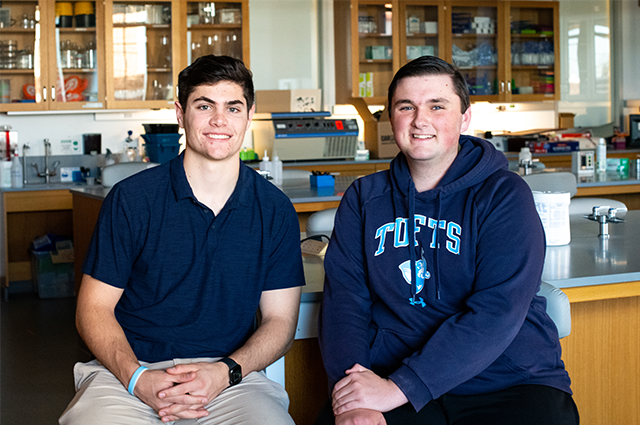Inventive by nature, engineers by calling: Patrick Solomon, E24, and Andrew Langley, E23

Patrick Solomon, E24, and Andrew Langley, E23
Biomedical engineering undergraduates Patrick Solomon, E24, and Andrew Langley, E23, are honing a shared interested in emerging cancer therapies in the Integrated Biofunctional Imaging & Therapeutics Laboratory (iBIT). They are part of an interdisciplinary team with backgrounds in electronics, signal processing, molecular biology, optics, and nanotechnology, led by Srivalleesha Mallidi, assistant professor of biomedical engineering. Last summer they worked alongside graduate student Allison Sweeney, E21, EG22 (who is now a Tufts research assistant in the same lab) on image-guided cancer therapies for pancreatic cancers using photoacoustic, and ultrasound imaging. Their study continues, expanding to include a broad range of drugs to further test whether tumor oxygenation status is a good indicator of a cancer therapy’s success.
Patrick Solomon: “To work in a cancer laboratory is an amazing opportunity, and for us, to specifically get experience with cutting edge imaging modalities such as photoacoustic imaging. Bioengineers see a lot of promise in photoacoustic imaging because it can track changes in oxygen as we treat cancer with a drug.”
Andrew Langley: “Right, it’s using an engineering mindset to look at biology. Basically you can think of it like a take on ultrasound. Instead of sending sound into the tissue, we send in light— we shoot lasers at the tumor and get sound back. Tumors tend to have variable oxygen levels so we’re looking to see if the oxygenation levels change—those levels will be an indicator of tissue death or of a tissue that is still very much alive.”
Solomon: “We assisted graduate student Allison Sweeney with trying to figure out if we can create a model to predict whether the drug, or cancer therapy, will work in the long term. Our study was looking at pancreatic cancer and drugs that are designed to shrink the tumor. In pancreatic cancer, the goal is to shrink it down so you can then have it surgically removed, not necessarily to wipe it out.
“Another part of why we chose this research was because you have such a short life expectancy if you’re diagnosed with pancreatic cancer. We are working on a model that, if it works, will tell you if a drug is working early on and change the treatment plan, and ultimately improve your odds of beating this cancer.”
Langley: “We’re trying to accelerate the response to the cancer. Rather than have to wait months to see if a treatment worked, move it up to maybe days after treatment. And that could be lifesaving.”
Solomon: “This has been an amazing experience as an undergraduate. We got such support from Professor Mallidi and her lab members; we are very grateful. There's so much we don't know about cancer and the treatment methods. They’re getting better every day, and to be a part of that progress was an incredible opportunity. To think that something that we're doing right now actually could have an impact on someone's life in the future— that is really cool.”
Langley: “To echo that: engineering classes introduce us to all these different concepts and they're all very theoretical and controlled. But when you get into the lab, especially in our field where a lot of these mechanisms are unknown, it becomes very real very quickly. We work with real human cancer cells. It's right there in front of you. Our second day we were brought to the lab and told, ‘This is a half million-dollar imaging machine that you guys are going be working with.’ Like, no pressure!”
Solomon: “What I like about being in this field is that, with an engineering degree, you can do anything you want. Also just knowing that the things that you're doing are actually making an impact in the world is pretty crazy.
“It’s interesting because there are some people in our lab who have no background in biology whatsoever. They're computer science people, electronics people. Any type of engineering discipline or science discipline can get interested in biomedical engineering. We all come with different strengths. We need all of that because the processes and the systems we're building are so complex that not one of us can know everything about it. I rely on our algorithms to be really good and fast. I don't understand how they work, but I know that someone else has set them up correctly. On the flip side the people writing those algorithms may not fully understand the biology of what we're looking for, but if we tell them we're looking for this signal, they can design our system to be able to pick that up. It's a really big group effort.”
Langley: “I will add that personally, this work is also very meaningful. I've had several family members who have died from cancer, and family members who have it now. Cancer touches all of us. But we’re improving treatment strategies all the time, and that gives me hope. And we know, if we're going to make a commitment to doing really great things, we have to be in it for the long haul, and we are.”
Department:
Biomedical Engineering